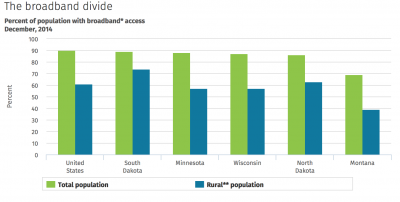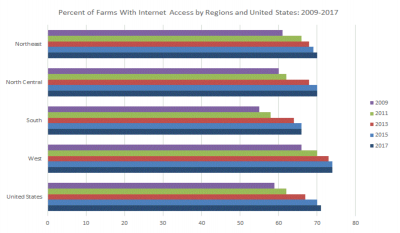The Agriculture Department received overwhelmingly negative feedback on its plan to relocate thousands of staff and consolidate dozens of offices, as employees, lawmakers and stakeholders said it could lead to…
Rural Broadband Issues- Farms Connecting to the Internet
Today’s update discusses rural broadband issues and federal regulatory action that was taken this month to help close the digital divide in Rural America. The update also touches on a couple of legislative proposals regarding broadband expansion, and highlights a recent USDA survey that documents how many farmers are using the Internet and how they are currently connecting.
Background
Recall that back in June, The Wall Street Journal published a detailed report on the availability of high speed Internet access in rural America.
The article, “Moving at the Speed of Dial-Up,” stated that, “In many rural communities, where available broadband speed and capacity barely surpass old-fashioned dial-up connections, residents sacrifice not only their online pastimes but also chances at a better living. In a generation, the travails of small-town America have overtaken the ills of the city, and this technology disconnect is both a cause and a symptom.
“Counties without modern internet connections can’t attract new firms, and their isolation discourages the enterprises they have: ranchers who want to buy and sell cattle in online auctions or farmers who could use the internet to monitor crops. Reliance on broadband includes any business that uses high-speed data transmission, spanning banks to insurance firms to factories.”
More recently, USA Today writer Sari Lesk reported this month that, “Local farmers, students and broadband industry leaders on [August 4th] asked federal officials to boost rural access to quality broadband in a local listening session with the federal Agriculture Secretary.
“Farmer Leslie Svacina said in the session that even basic business functions are difficult without reliable high-speed internet access.
“‘Just sending an email is a challenge,’ Svacina said.”
After Rural Prosperity Task Force mtg in Wausau, @RepSeanDuffy & @SenRonJohnson agree broadband vital to rural econ rebound. #BackToOurRoots pic.twitter.com/kXBKUZ1hQj
— Sec. Sonny Perdue (@SecretarySonny) August 4, 2017
The article noted that, “U.S. Department of Agriculture Secretary Sonny Perdue said addressing that issue is one of the keys to improving rural prosperity.
‘Broadband connectivity today is that water and sewer of the 20th century, and it’s become a necessity,’ he said. Perdue said the issue affects a variety of areas including business and education.
Meanwhile, an article last week at The Fedgazette (Federal Reserve Bank of Minneapolis- “Border-to-Border Dreams“) explained that, “Alternatives to wireline broadband often deliver lower speeds or are more expensive. Fixed wireless networks require transmission towers as well as fiber connections, and obstacles such as hills and trees can interfere with the signal, [Bill Coleman, a broadband consultant who has advised on projects all over Minnesota] said. Cell phone service is slow and coverage often spotty outside metro areas, while satellite links are pricey and vulnerable to weather disruptions.
“These economic and technological realities have created a sharp divide between urban and rural areas when it comes to broadband access.”
In 2014, access to high-speed internet service outside urbanized areas lagged overall access nationwide and in every district state, according to the latest available data from the Federal Communications Commission.

Bridging the Rural Digital Divide- Regulatory Relief, Congressional Action
Earlier this month, Wall Street Journal writer John D. McKinnon reported that, “Federal regulators took steps [on August 3rd] to close the digital divide in rural America, moving to reshape two subsidy programs that they say haven’t been as effective as needed.
“Expanding access to broadband in hard-to-serve areas across the U.S. has proved a challenge for years, not only because of costs, but also because of the rapidly changing technology itself.
“Lawmakers praised the Federal Communications Commission’s move but noted that regulatory action can only go so far given that big new investments would still have to be authorized by Congress to bridge the divide. Some are expecting the Trump administration to include broadband expansion in a detailed infrastructure proposal in early September. Efforts to move an infrastructure bill through Congress have stalled so far this year.”
FCC established the challenge process for Mobility Fund Phase II, another step to close the #digitaldivide https://t.co/HxJJ84g2dY
— The FCC (@FCC) August 3, 2017
The Journal article added that, “Sen. Roger Wicker (R., Miss.) said he expected the Trump administration to address the digital divide in rural areas in its long-awaited infrastructure proposal.
“‘We’re going to have to go beyond what is happening under current law and current available funds,’ said Mr. Wicker, who chairs a Senate subcommittee on communications and technology.”
“The FCC estimates that in urban areas, 97% of Americans have access to high-speed fixed service. But in rural areas it is 65%, and 60% on tribal lands,” the Journal article said.
Meanwhile, a news release last week from Senate Ag Committee Member Kirsten Gillibrand (D., N.Y.) stated that, “[Sen. Gillibrand] and U.S. Senator Shelley Moore Capito (R-WV) announced the Broadband Connections for Rural Opportunities Program Act, also known as the B-CROP Act. This bipartisan bill would make grant funding available for rural broadband projects in high-need areas to be awarded in combination with the current loan funding available through USDA’s Rural Utilities Service.
“‘There is no doubt anymore that students and businesses in today’s world must have access to high-speed internet in order to get ahead, but too many of our rural communities still lack access to this essential technology,’ said Senator Gillibrand.”
The release added that, “The B-CROP Act proposes policies to target federal funds to rural and tribal areas in the highest of need to connect all Americans, regardless of where they live, work, or retire, to the technology necessary to succeed in the 21st century. Without access to high-quality, affordable broadband service, workers have fewer opportunities for good-paying jobs, farmers and business owners are isolated from new markets, children are limited in their educational opportunities and health care providers do not have reliable access to the most advanced technology available to help patients.”
And earlier this year, a news release from House Ag Committee Member Tom O’Halleran (D., Ariz.) indicated that, “[Rep. O’Halleran] made a commitment to rural communities across the 1st District by cosponsoring the New Deal Rural Broadband Act, a bill to invest in broadband internet infrastructure across the country.
“‘Access to reliable, high speed Internet is critical for the economic livelihood of our rural communities. This bill would expand access to education opportunities for our children and encourage innovation in our business community,’ said Rep. O’Halleran. ‘Arizona families all across the district will see a benefit from this commonsense investment.'”
Investing in rural broadband opens up more economic and educational opportunities for our children. #AZ01 https://t.co/SLJrnciRw4 pic.twitter.com/reso0TfERO
— Rep. Tom O'Halleran (@RepOHalleran) August 20, 2017
Farm Internet Use- Access and Method, USDA- NASS Survey
In a more narrow look at current Internet use among U.S. farmers and how they are connecting to the Internet, late last week, the USDA’s National Agricultural Statistics Service (NASS) released its Farm Computer Usage and Ownership report, which is published every other year.
The report includes, “Data on farm computer usage, including computer access, ownership or leasing, farm business use, and internet access. Estimates are presented for the US, by State, region, economic class, and type of farm.”
In part, Friday’s report stated that, “In 2017, USDA-NASS added two additional methods that farmers could select for accessing the Internet. Fiber-optic and mobile Internet service for a cell phone or other device are the two access methods added to the Farm Computer Usage and Ownership report. Fiber-optic was used by 8 percent of the farms, and mobile Internet service was used by 17 percent. However, DSL (Digital Subscriber Line) connection continues to be the most common method of accessing the Internet, with 29 percent of the farms in the United States using it, down from 30 percent in 2015. A satellite connection, at 21 percent, remained steady from 2015. Other reported methods of accessing the Internet include cable modem service, dialup service, and other or don’t know.
Cable modem service is at 15 percent, up 3 percentage points from 2015. Dialup service is at 2 percent, down 1 percentage point from 2015.
The NASS update also noted that, “A new question in 2017, reported 39 percent of producers nationally use a tablet or smart phone for farm business.”
The report indicated that 71 percent of farms in the Unites States have Internet access, while in Illinois, that percentage increases to 78 percent.

The NASS report showed that farms in the western part of the United States had a relatively larger percent of farms accessing the Internet than other geographic regions.

In a closer look at how Illinois farms connect to the Internet, the NASS report included the following tables demonstrating that in 2017: two percent of farms connect with dialup, 26 percent with DSL, 11 percent with cable, five percent with fiber optic, 16 percent mobile, and 32 percent with satellite (the remaining 8 percent of farms were other/unknown).


Iowa: DSL connection is now the most common method of accessing the Internet for farms-- 26%, @usda_nass pic.twitter.com/1kl1moAEav
— Farm Policy (@FarmPolicy) August 18, 2017





